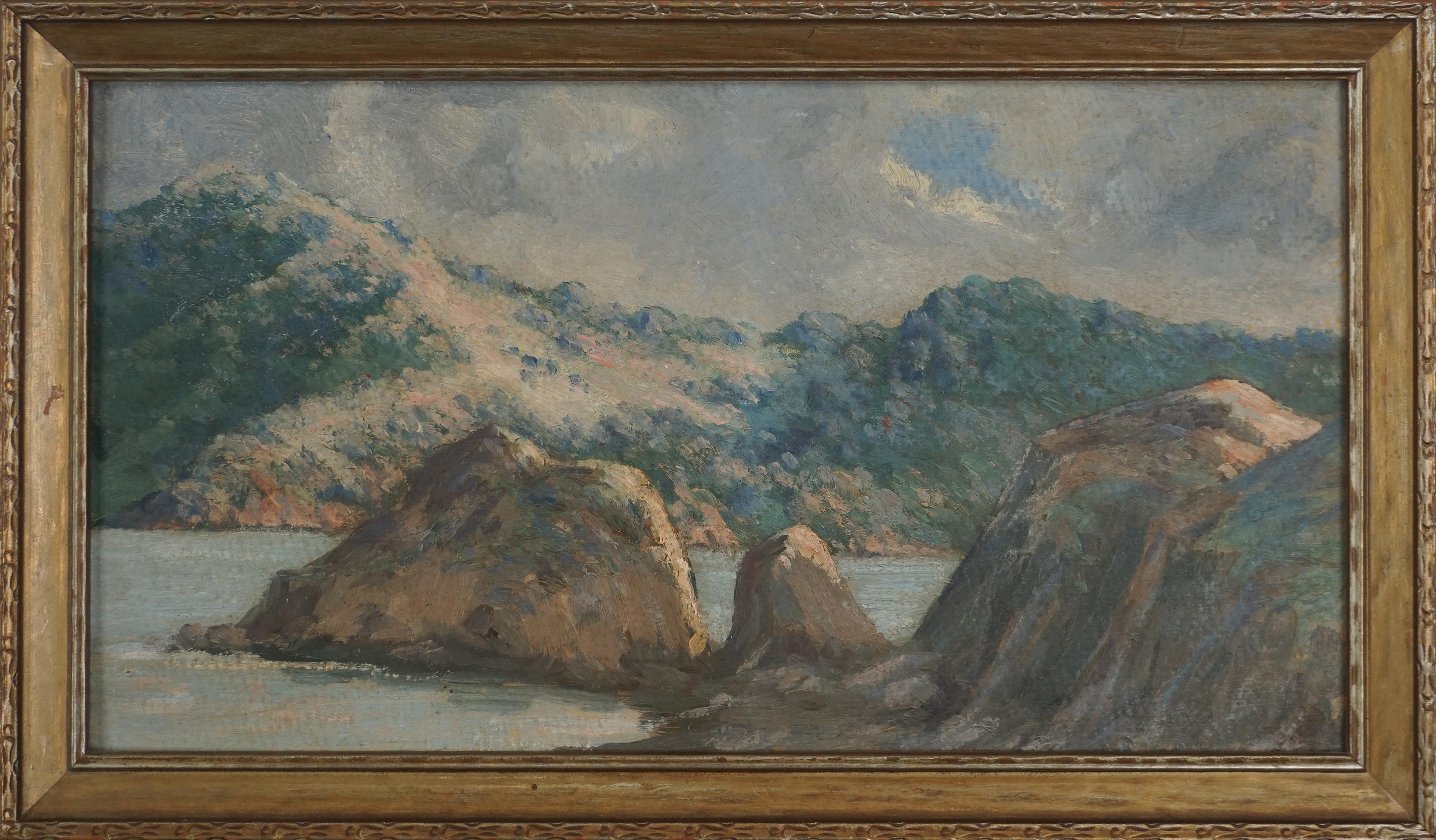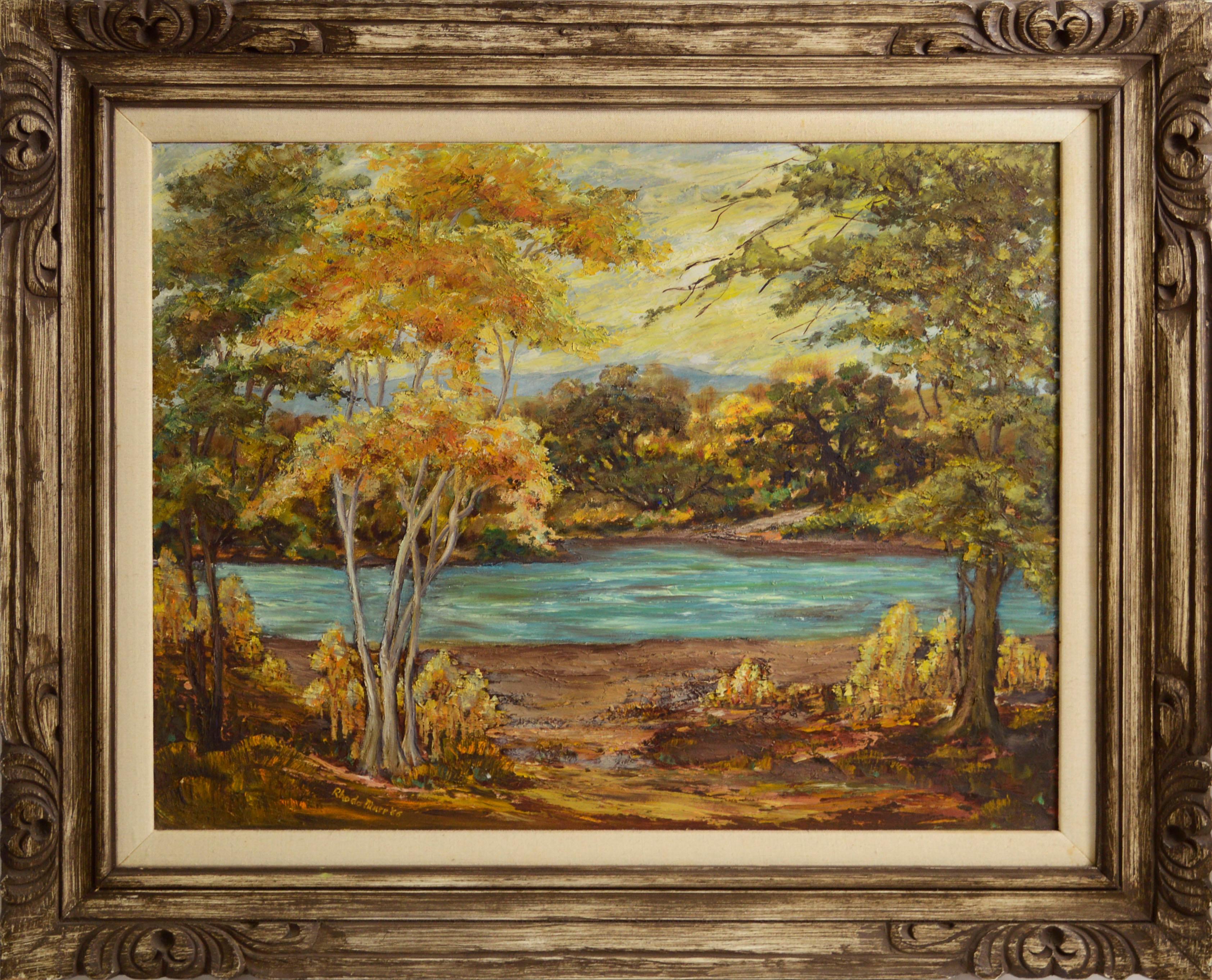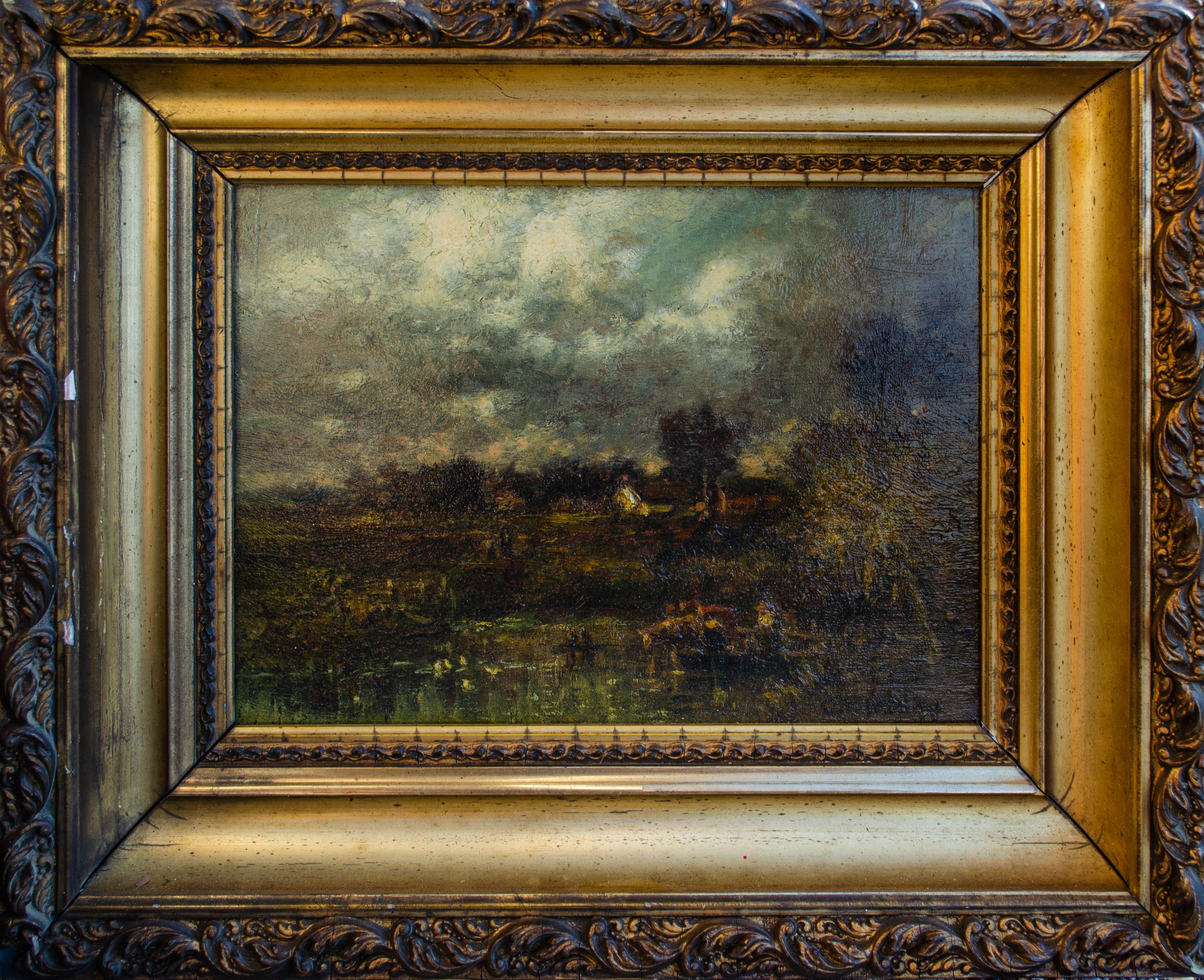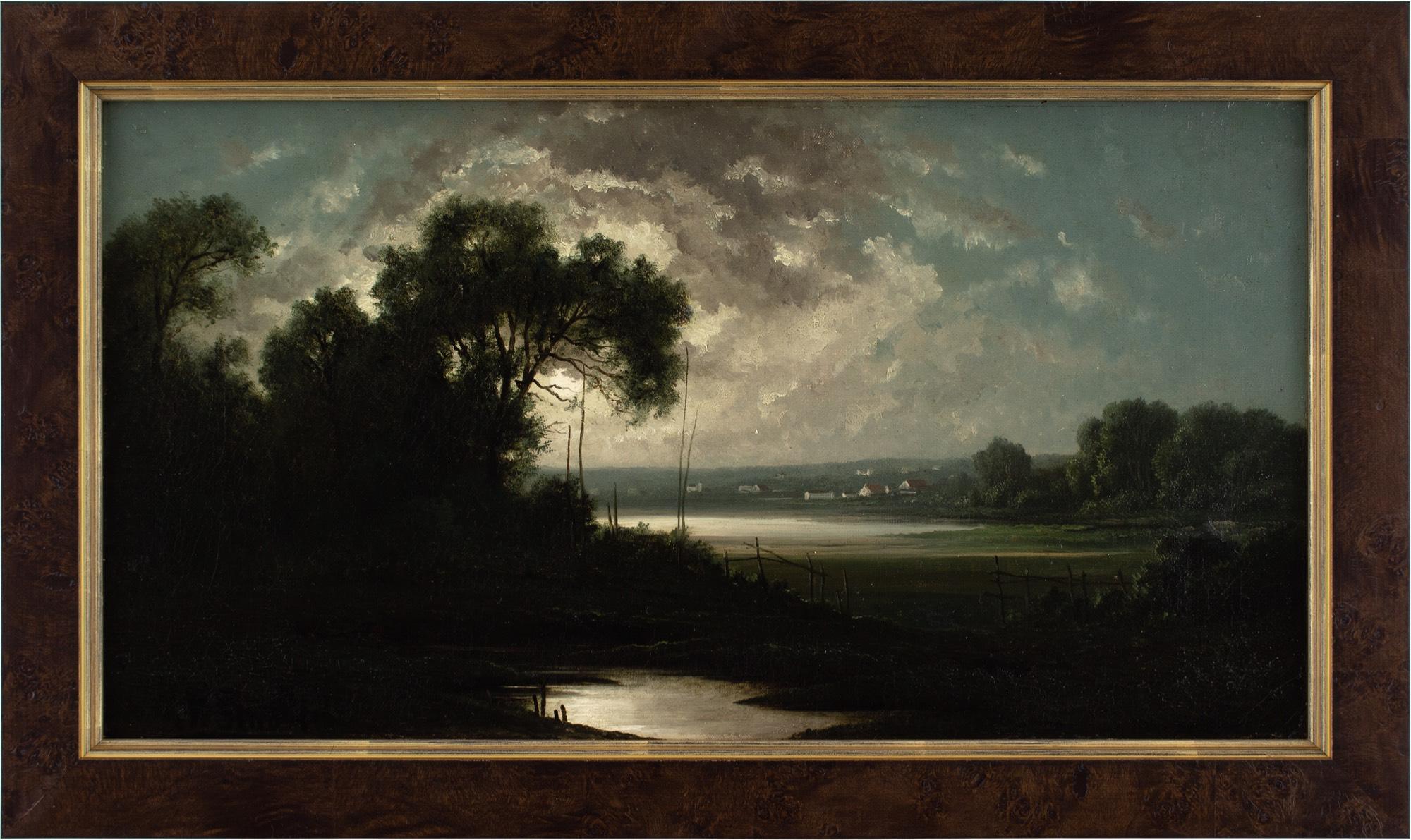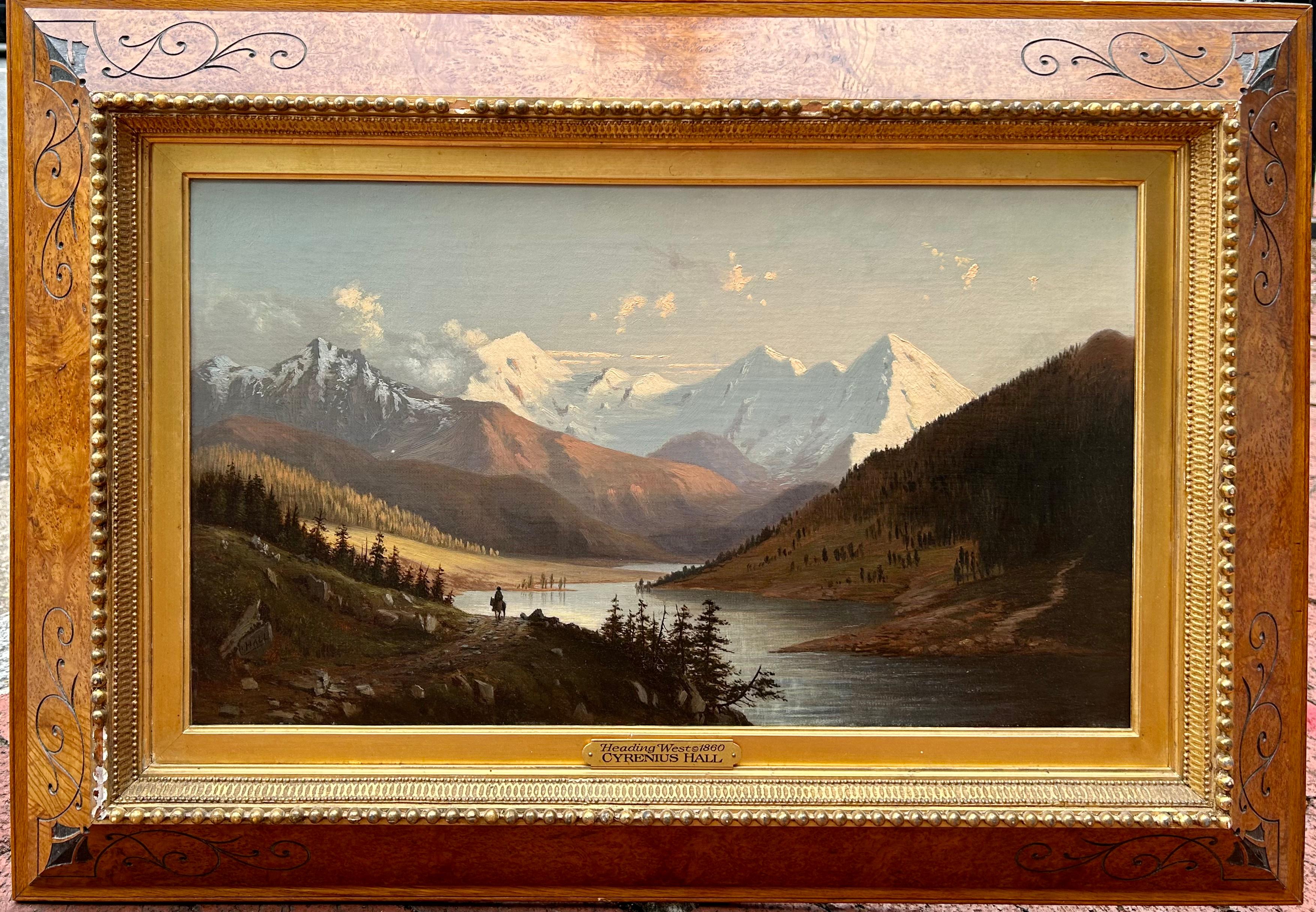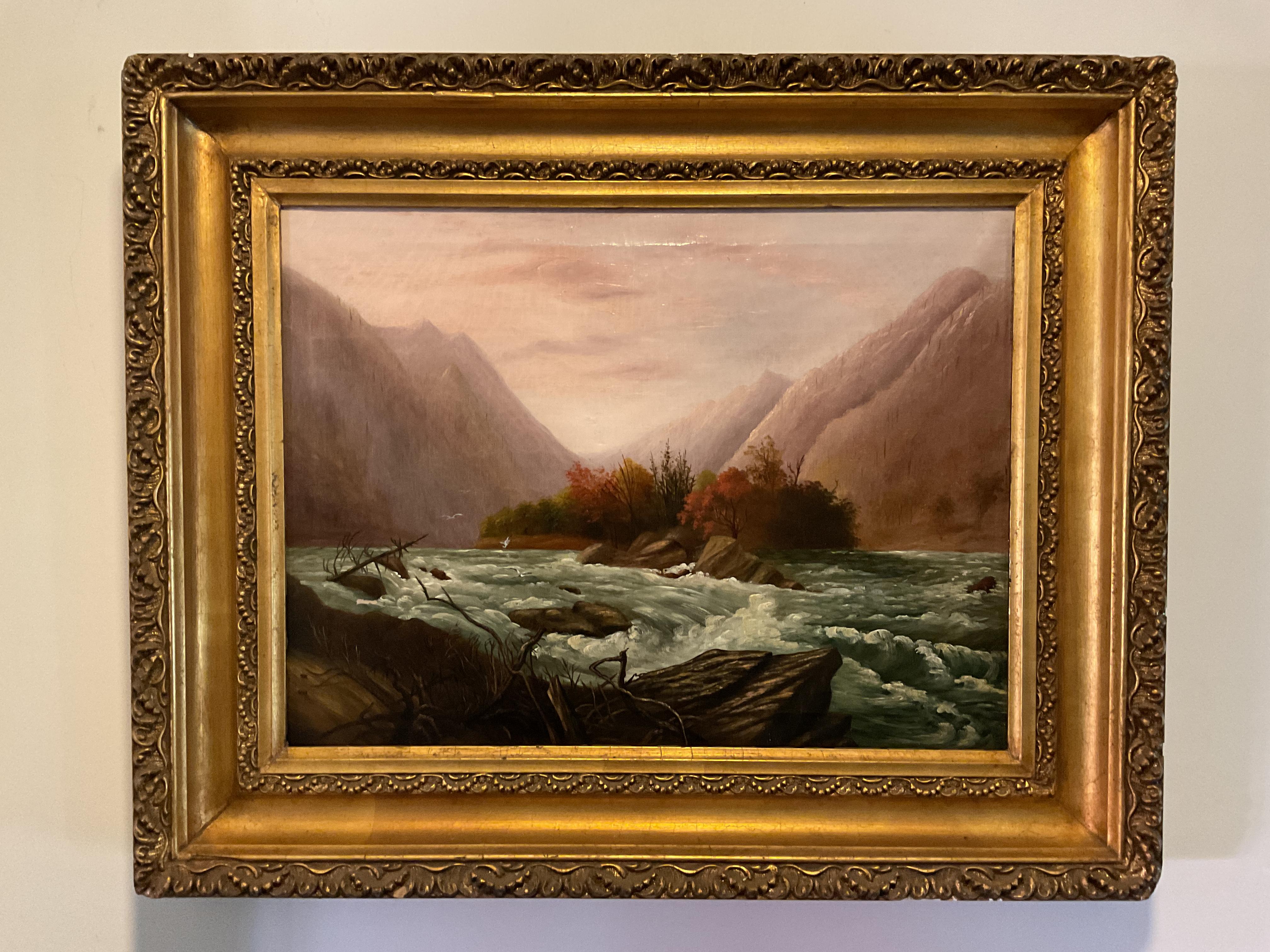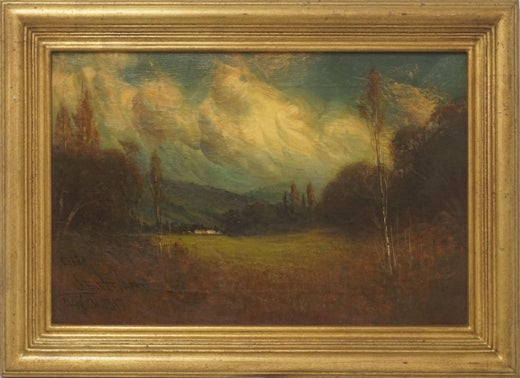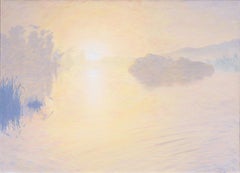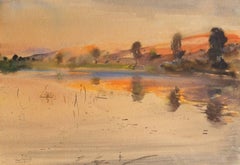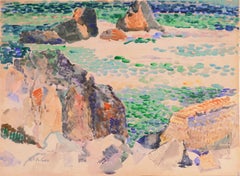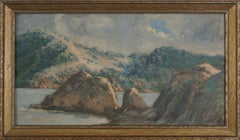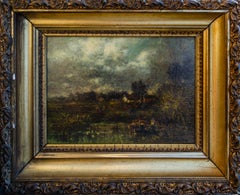Items Similar to 'The Sacramento River, Rio Vista', California, Bohemian Club, White House, SFSD
Want more images or videos?
Request additional images or videos from the seller
1 of 15
James Everett Stuart'The Sacramento River, Rio Vista', California, Bohemian Club, White House, SFSD1919
1919
$9,500
£7,212.24
€8,249.26
CA$13,272.88
A$14,762.34
CHF 7,708.43
MX$179,641.94
NOK 98,448.46
SEK 92,327.29
DKK 61,567.40
Shipping
Retrieving quote...The 1stDibs Promise:
Authenticity Guarantee,
Money-Back Guarantee,
24-Hour Cancellation
About the Item
'The Sacramento River, Rio Vista', California, Bohemian Club, White House, SFSD
Signed lower left, 'J. E. Stuart' for James Everett Stuart (American, 1852-1941) ), dated 'Jan. 31, 1919' and with the artist's chronology number '2596'; additionally signed, verso, titled, 'Sunset' and inscribed, 'The Sacramento River, near Rio Vista, California. Painted Jan. 31, 1919' with artist's chronology number, dimensions and original sale price. ($5,000.)
Born in Bangor, Maine, James Everett Stuart became celebrated for his panoramic American landscapes. He traveled and painted widely from Maine to California and from Alaska to the Panama Canal. He is now particularly known for his landscapes of the American West, particularly for his dramatic views of Northern California and Oregon. Stuart painted over 5000 paintings during his lifetime and he kept meticulous notes concerning weather and atmosphere as well as assigning a unique stock number to each completed work.
James Everett Stuart first studied in San Francisco with Raymond Yelland, Thomas Hill, and William Keith at the San Francisco School of Design. His early work was focused on dramatic California landscapes including views of the Sacramento and San Joaquin rivers. His original style was influenced the French Barbizon School. In 1876, Stuart traveled through the north-western United States and, in 1881, opened his first studio in Portland, Oregon. From here, he traveled throughout the United States and Mexico. His favored subjects included the Yosemite National Park as well as old California missions and adobes.
During much of the 1890s, he lived in Chicago, but returned to San Francisco in 1912. With a new studio near Union Square, he became highly sought after by the public and and popular among his peers. This commercial and critical success was underscored by his election to membership of the Bohemian Club. James Everett Stuart is well-listed in all relevant art reference works including Who Was Who in American Art and Benezit's Dictionary of Artists. His work may be found in many private and public collections nationwide including in the permanent collection of the White House in Washington D.C.
Reference:
Who Was Who in American Art 1564-1975: 400 Years of Artists in America, Peter Hastings Falk, Sound View Press 1999, Vol. 3, page 3210; Artists in California 1786-1940, Third Edition, Edan Milton Hughes: Crocker Art Museum, Sheridan Books 2002, Vol. 2, page 1076; E. Benezit, Dictionnaire des Peintres, Sculpteurs, Dessinateurs, et Graveurs, Jacques Busse, 1999 Nouvelle Édition, Gründ 1911, Vol. 13, page 325; Mallett’s Index of Artists, Daniel Trowbridge Mallett, Peter Smith: New York 1948 Edition, R.R. Bowker Company 1935, page 425; Mantle Fielding’s Dictionary of American Painters, Sculptors and Engravers, Glen B. Opitz, Apollo Press 1983, page 908; et al.
- Creator:James Everett Stuart (1852-1941, American)
- Creation Year:1919
- Dimensions:Height: 24 in (60.96 cm)Width: 42 in (106.68 cm)Depth: 0.13 in (3.31 mm)
- Medium:
- Period:
- Condition:painting: canvas laid down on masonite; minor restoration, minor craquelure; unframed; shows well.
- Gallery Location:Santa Cruz, CA
- Reference Number:1stDibs: LU34415953572
James Everett Stuart
Born in Bangor, Maine, James Everett Stuart became known for his panoramic landscapes from Maine to California to Alaska to the Panama Canal, but especially of the American West with focus on Northern California and Oregon. Reportedly he painted more than 5000 paintings during his lifetime and originated a method of painting on aluminum and wood with a special adhering process that he thought made his work quite durable but proved not to be so. He also wrote on the back of most of his paintings His parents took him to California at the age of eight, and the family settled in San Francisco where he attended the public schools and studied art with Virgil Williams, Raymond Yelland, Thomas Hill, and William Keith at the San Francisco School of Design. His early work was dramatic California landscape including the Sacramento and San Joaquin rivers, and in style the works were moody and mysterious and suggestive of the French Barbizon School. He first traveled to the Northwest in 1876, and in 1881, he opened his studio in Portland, Oregon and from there traveled throughout the West and East Coast and into Mexico. Subjects included Yosemite as well as California missions and adobes. He painted landscapes whose sales ultimately were financially remunerative and which established his reputation. in 1885, he first went to Yellowstone where he camped for several weeks, supplied himself with fish for food, climbed steep cliffs including Electric Peak, and filled his sketchbook for studio paintings. The following summer, Stuart returned, having negotiated a free pass from the Northern Pacific Railroad in exchange for paintings. At the end of the summer, he went East to New York City on the return part of his train pass. Settling a studio in New York for four years, he continued to arrange several more summer railroad passes to Yellowstone. He was unable to arrange a formal arrangement for painting sales from the Park's gift shop, so he sold paintings from his tent. Of those years, he expressed that he much preferred being in the park to studio painting, but he stopped visiting in 1889 and instead traveled to Alaska and the Coastal Range. During much of the 1890s, he lived in Chicago, but in 1912 returned to San Francisco until his death in 1941. There, from his studio near Union Square, he was highly successful and popular among his peers, underscored by his membership in the Bohemian Club. Many of the owners of old homes in California have his paintings on the wall, suggestive of a time of grandeur. One of his paintings is in the White House, and his work is in the historical societies of Oregon, Washington, and Montana.
About the Seller
5.0
Platinum Seller
Premium sellers with a 4.7+ rating and 24-hour response times
Established in 1982
1stDibs seller since 2013
741 sales on 1stDibs
Typical response time: 1 hour
- ShippingRetrieving quote...Shipping from: Santa Cruz, CA
- Return Policy
Authenticity Guarantee
In the unlikely event there’s an issue with an item’s authenticity, contact us within 1 year for a full refund. DetailsMoney-Back Guarantee
If your item is not as described, is damaged in transit, or does not arrive, contact us within 7 days for a full refund. Details24-Hour Cancellation
You have a 24-hour grace period in which to reconsider your purchase, with no questions asked.Vetted Professional Sellers
Our world-class sellers must adhere to strict standards for service and quality, maintaining the integrity of our listings.Price-Match Guarantee
If you find that a seller listed the same item for a lower price elsewhere, we’ll match it.Trusted Global Delivery
Our best-in-class carrier network provides specialized shipping options worldwide, including custom delivery.More From This Seller
View All'Santa Barbara Bird Sanctuary', Ventura Art Museum, Large Oil, UCSB, MFA, PAMF
By Richard Schloss
Located in Santa Cruz, CA
Initialed lower right, 'R. S.' for Richard Schloss (American, born 1953) and dated 1982; additionally signed and dated, verso.
A substantial and luminous landscape by this well-lis...
Category
1980s Impressionist Landscape Paintings
Materials
Canvas, Oil
'Sunset Landscape', Hamburg, Rivne, Volhynia, Rivne Museum
Located in Santa Cruz, CA
Signed lower right, 'G. Kosmiadi' for Georg Kosmiadi (Ukranian-German, 1886-1967) and dated, '66'; additionally signed verso, 'Georg Kosmiadi', inscribed with serial number and dated, '20/9/66'.
Georg Kosmiadi was a resident of Rivne before moving to Hamburg in 1940 where he worked as an art teacher. Kosmiadi exhibited at the Rivne Regional Museum and a regional art...
Category
1960s Abstract Impressionist Abstract Drawings and Watercolors
Materials
Paper, Gouache
'Late Sunset, California', LACMA, Laguna Beach Art Association, PAFA, CWS
By Karl Yens
Located in Santa Cruz, CA
Signed lower left, 'Karl Yens' (American, 1868-1945) and painted circa 1920.
A fine, early 20th century watercolor landscape showing the the luminous sunset serenely reflected in a still lake with elegant, calligraphic grasses.
Painter, illustrator, etcher and muralist, Karl Yens was born in Germany and first studied with Max Koch in Berlin and, subsequently, with Benjamin-Constant and Jean-Paul Laurens in Paris. He was a successful active muralist in both Germany and Scotland before immigrating to the United States in 1901. After arriving in America, Yens continued to paint murals in New York City and Washington, D.C. before settling in Southern California where he lived and painted until his death in 1945.
Karl Yens exhibited widely and with success, including at the 1915 Panama-California International Exposition in San Diego, Los Angeles County Museum of Art, Philadelphia Academy of Fine Arts, the Duquesne Club of Pittsburgh, San Diego Museum, the Orange County, California Museum, Astor Theatre in NYC and the Society of California Pioneers. He was the recipient of numerous medals and prizes and juried awards, including at the 1919 California Art Club, Laguna Beach Art...
Category
Early 20th Century Impressionist Landscape Drawings and Watercolors
Materials
Paper, Watercolor
'California Coast', Corcoran, Bohemian Club, MoMA, AIC, CSFA, LACMA, SFAA
Located in Santa Cruz, CA
Estate stamped, lower left, 'Wm. A. Gaw' for William Alexander Gaw (American, 1891-1973) and painted circa 1935.
William Alexander Gaw was born ...
Category
1930s Post-Impressionist Landscape Drawings and Watercolors
Materials
Watercolor, Gouache, Postcard
'River Landscape with Rider', English School, Barbizon
Located in Santa Cruz, CA
An unsigned, English school landscape painted circa 1860 painted by a skilled but unidentified hand, perhaps a follower of George Augustus Williams (English, 1814-1901).
A particular...
Category
1870s Other Art Style Landscape Paintings
Materials
Canvas, Masonite, Oil
'Evening Landscape' Bay Area Abstraction, San Francisco Museum of Fine Arts, CWS
By Robert George Gilberg
Located in Santa Cruz, CA
Signed lower right, 'Gilberg' for Robert George Gilberg (American, 1911-1970) and painted circa 1965.
Born in Oakland, Robert George Gilberg first studied at the Oakland Art Center during the 1930s. Following service during WWII, he settled in Nevada City, California where he lived and painted until shortly before his death in San Francisco. Gilberg exhibited widely and with success and was the recipient of numerous medals, prizes and juried awards, including at the San Francisco Museum of Fine Arts...
Category
1960s American Modern Landscape Drawings and Watercolors
Materials
Paper, Ink, Watercolor
You May Also Like
Mid 20th Century California Plein Air American River Landscape Walter F Mire
Located in Soquel, CA
Wonderful mid 20th century impressionist landscape of California's American River by Walter F. Mire (American, 1916 - ?), circa 1945. Signed o...
Category
1930s Impressionist Landscape Paintings
Materials
Masonite, Oil
"Sacramento River", Mid Century California Landscape
Located in Soquel, CA
A gorgeous mid century American Impressionist landscape of the Sacramento River flowing through the vibrant forest as the seasons change by California...
Category
1960s American Impressionist Landscape Paintings
Materials
Canvas, Oil
$680 Sale Price
20% Off
Charles Henry Miller Hudson River School landscape of Queens, NY
By Charles Henry Miller
Located in New York, NY
Charles Henry Miller (American, 1842-1922)
Untitled, c. Late 1800s-Early 1900s
Oil on board
9 x 12 in.
Framed: 14 5/8 x 17 3/4 in.
Signed lower right: C.H. Miller
Charles Henry Miller was a noted artist and painter of landscapes from Long Island, New York. The American poet Bayard Taylor called him, "The artistic discoverer of the little continent of Long Island."
Miller was educated at Mount Washington Collegiate Institute, and graduated in medicine at the New York Homeopathic Institute in 1864. Before his graduation, he had occasionally painted pictures, and in 1860 he exhibited The Challenge Accepted at the National Academy of Design, in New York City.
He lived in Queens at the summer estate, Queenslawn, originally purchased by his parents. He went abroad in 1864 and again in 1867, and was a pupil in the Bavarian Royal Academy at Munich under the instruction of Adolf Lier.
After the 1874 death of his father, Jacob Miller, who was a wealthy architect and builder, Miller received a large inheritance that allowed him to paint as an independent artist for the remainder of his long life. He worked seriously and exhibited regularly, including at international exhibitions.
The majority of his oil paintings depict Long Island subjects, especially those in and around Queens Village. Fed up with the development of the eastern part of Queens (present-day Nassau County), he began to spend part of his summers in East Marion, Long Island, c. 1910. Here he spent his time sketching and painting the surrounding areas.
In 1885 he published The Philosophy of Art in America, using the pseudonym Carl De Muldor (he was descended from the De Muldor family).
His work was recognized: in 1873, he was elected an associate of the National Academy of Design and an academician in 1875. He served as president of the New York Art Club in 1879 and of the American Committee at the Munich International Exposition in 1883.
Legacy and honors
• In 1910 Miller founded the Queens Borough Allied Arts & Crafts Society.
• A New York City public school, Queens P.S. 33, was once named for him.
• 1878, gold medal awarded by the Massachusetts Charitable Association
• 1885, gold medal at the World's Exposition in New Orleans.
Following is a list, which includes many of his known exhibitions:
• National Academy of Design, New York, NY, 1860-61, 1865-67, 1870-1921
• Brooklyn Art Association, Brooklyn, NY, 1872-84, 1891-92
• Artist's Fund Society, New York, NY, 1874 (exhibition & sale), 1886 (exhibition & sale)
• Century Association, New York, NY, (1874-1917)
• Philadelphia Centennial Exhibition, Philadelphia, PA, 1876 (prize)
• Society of American Artists, New York, NY, (1878-1882)
• Massachusetts Charitable Mechanic Association, Boston, MA, 1878 (prize)
• Paris International Exposition, Paris, France, 1878, 1889
• American Water Color Society Exhibition, New York, NY, 1879
• Pennsylvania Academy of Fine Arts, Philadelphia , PA, 1879-99
• Boston Art Club, Boston, MA, 1880-1907 (prize)
• Union League Club, New York, NY, 1880
• Lotos Club, New York, NY, 1880, 1896, 1899-1900, 1906
• Salons of Paris, Paris, France, 1882
• International Exhibition, Munich, Germany, 1883 (president & exhibitor)
• New Orleans Exposition, New Orleans, LA, 1885 (prize)
• Art Institute of Chicago, Chicago, IL, 1888-89, 1891, 1894-98, 1904
• Fifth Avenue Art Gallery, New York, NY, 1889 (exhibition & sale)
• World's Columbian Exposition, Chicago, IL, 1892
• Frederick A. Chapman Gallery, New York, NY, 1898 (solo)
• Miller Studio...
Category
Early 20th Century American Impressionist Landscape Paintings
Materials
Canvas, Foam, Oil
Robert T Stuart, River Landscape, Evening Mood
Located in Cheltenham, GB
This evocative mid-19th-century oil painting by Robert T Stuart (XIX) depicts a picturesque river landscape illuminated by a setting sun.
A silhouetted wood stands before a majestic...
Category
1860s French School Landscape Paintings
Materials
Oil, Canvas
Oil Landscape of West on Snake River
By Cyrenius Hall
Located in Fredericksburg, VA
Cyrenius Hall was an artist who painted Western landscapes in a luminous style. He first went to Portland, Oregon in 1853 and 1854 over the Oregon Trail. From there he executed views...
Category
Early 19th Century Hudson River School Landscape Paintings
Materials
Canvas, Oil
Rare Southern Painting of the French Broad River, North Carolina ca 1890
Located in Baltimore, MD
This is an unsigned, but rare, late 19th century oil on canvas of a view of the French Broad River in North Carolina. It is amongst the world’s oldest rivers. The scene depicted is mountainous and the water is swiftly moving. This would put the location at the northern end of its course, north of Asheville and near the North Carolina and Tennessee border.
Much like the Hudson River School in...
Category
1880s Romantic Landscape Paintings
Materials
Oil
More Ways To Browse
Bohemian French Art
Antique French Dictionary
Bohemian Engraved
Thomas Hill Oil Painting
Yosemite Oil Painting
Raymond Price
Antique Oregon
Antique Crocks
Hastings Antique
Alaska Oil Paintings
Raymond Page
Thomas Smith Oil
Early California Mission Paintings
R Hughes
Hughes E J
Antique Brown Crock
Adobe House
Thomas Hughes
